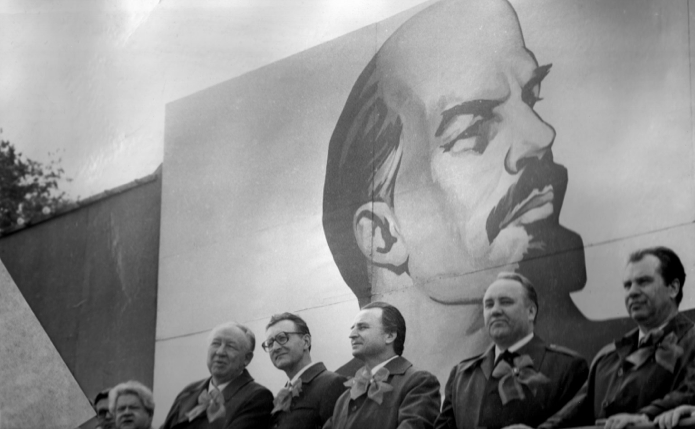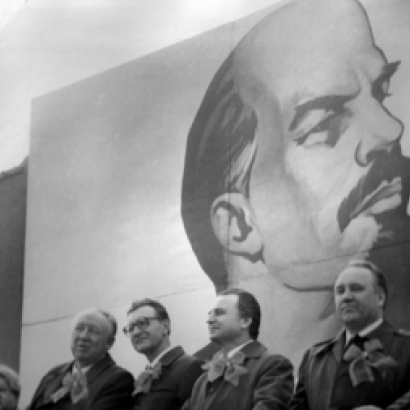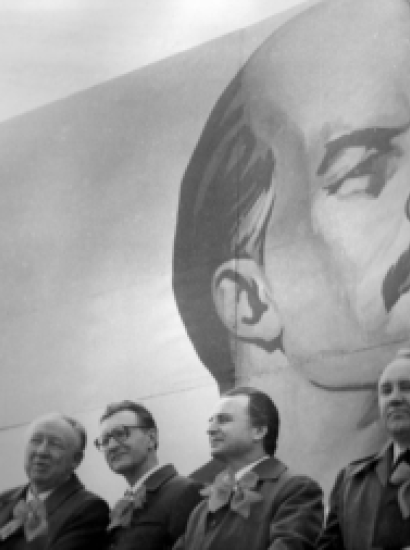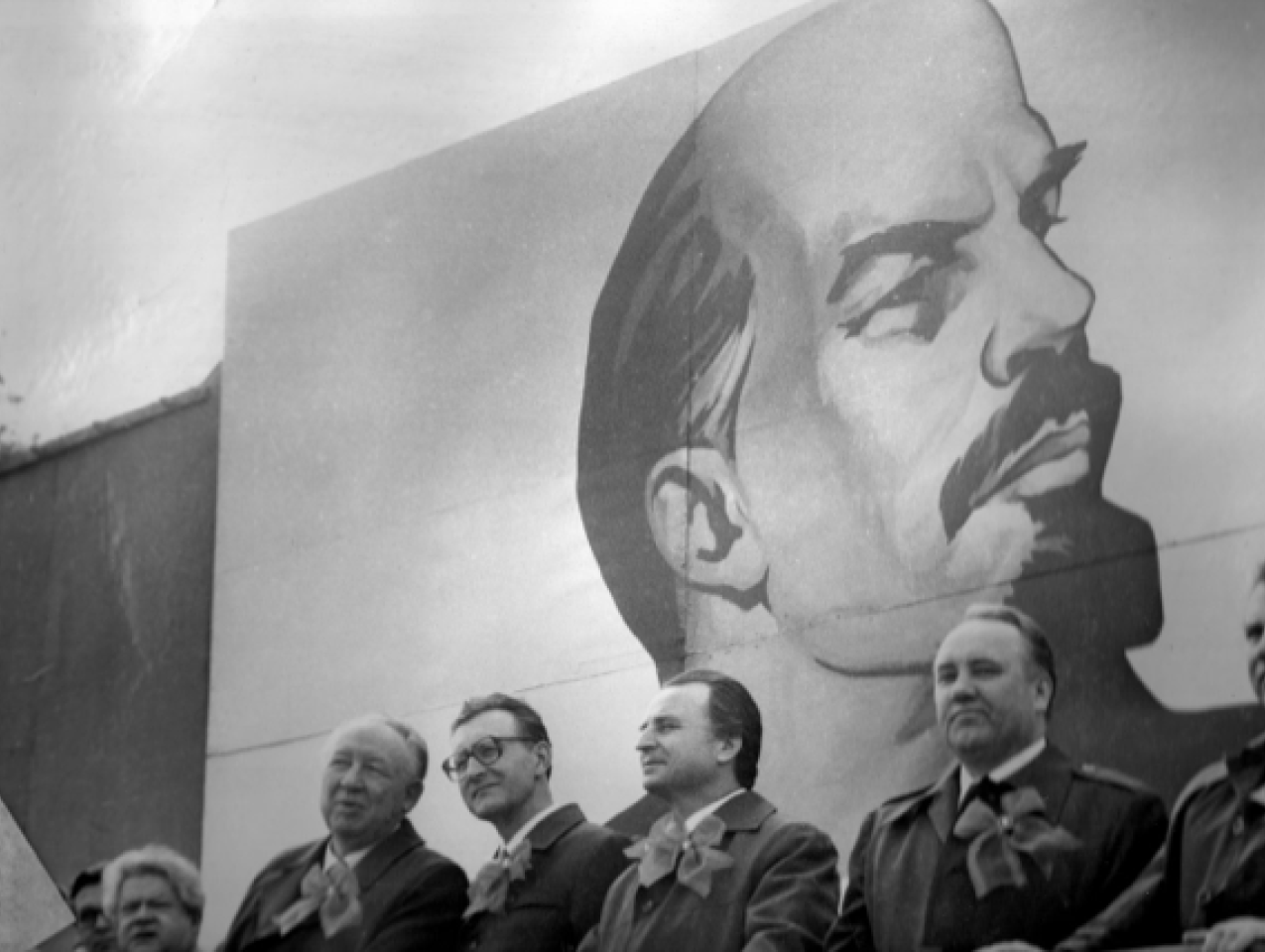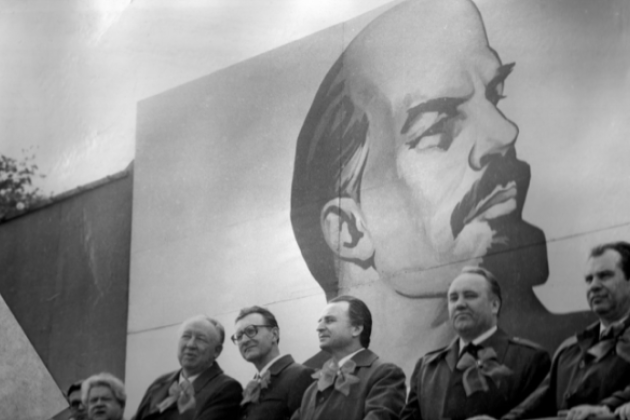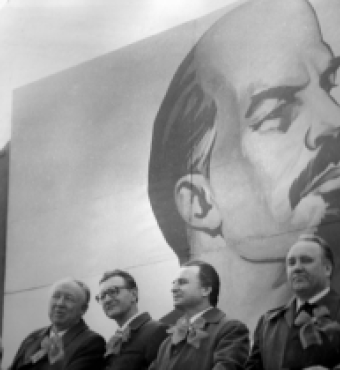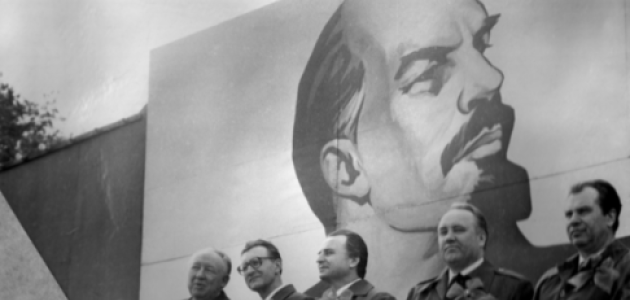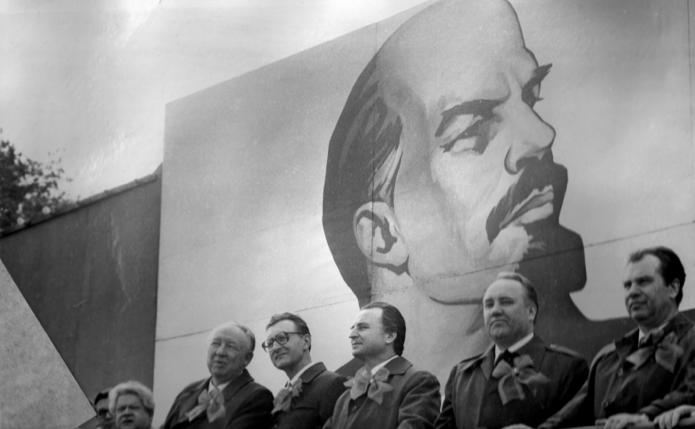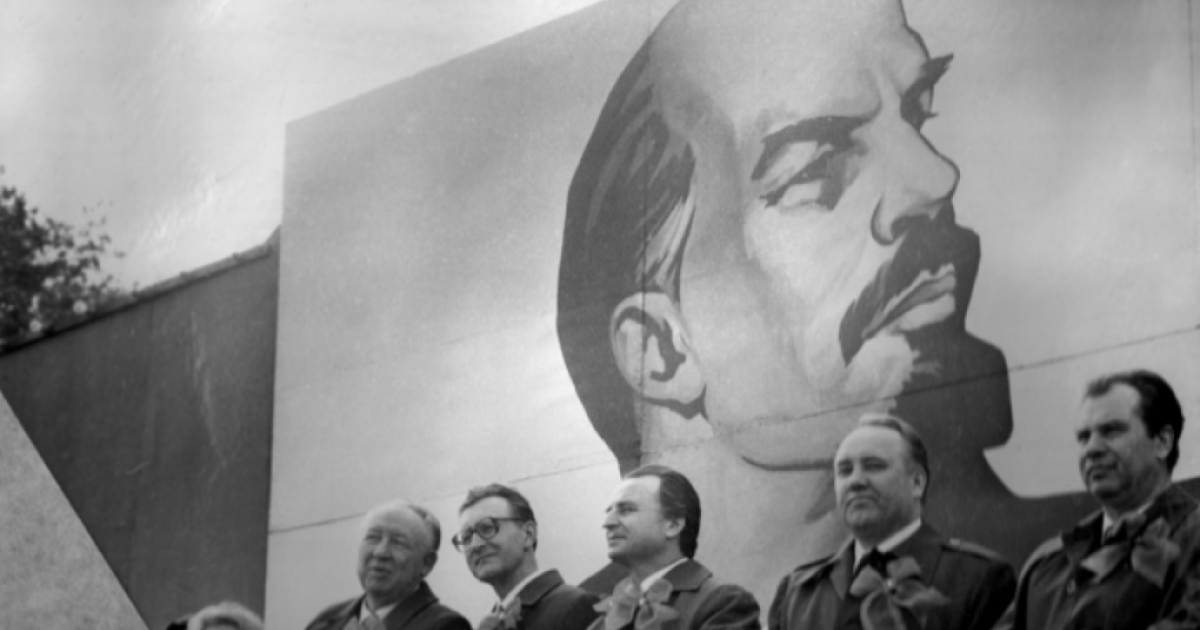- Energy & Environment
Editor’s note: This essay is an excerpt of the new book A Memoir of the Missile Age: One Man’s Journey (Hoover Press) by Vitaly Katayev (1932–2001). Katayev joined the Defense Industry Department of the Central Committee of the Soviet Communist Party in 1975, after fifteen years as a designer in the Soviet defense industry, ultimately rising to deputy head of defense under Gorbachev and serving until the department was disbanded in 1993.
Almost all my life, I worked for the military-industrial complex. I not only observed the development of the Cold War processes but participated in them. I worked in design bureaus and was a specialist in aviation and missile systems, during which time I joined the communist party. After that I worked as an instructor, head of a sector, and then deputy head of the Central Committee Defense Department. There, I supervised issues related to sea-based strategic weapons and was involved with various government defense agencies in crafting military policy and negotiating weapons reduction. As part of the interdepartmental working group, I directly participated in international talks, working out security concepts and preparing texts of treaties. All this gave me a special insider’s view of arms development and limitation before and after the dissolution of the USSR.
The economy used to be divided into specialized subdivisions in the Soviet Union, including light industry, machine-tool construction, instrument-making industry, agriculture, and others. Branches that produced military products were grouped separately into the military-industrial complex. This group comprised nine ministries—Aviation, Machine-Building, General Machine-Building, Defense Industry, Radio Industry, Medium Machine-Building, Communications, Ship-Building, and Electronic Industry—as well as all institutes, design bureaus, and plants which developed and made armaments and military technology.
The key feature of the military-industrial complex in the Soviet Union was the fact that the enterprises that made up the backbone of the defense industry belonged to the state. This was the situation until the Soviet Union disintegrated. The Soviet military industry was always completely closed. Specialists had no right to talk about their work. They had to sign a written statement to this effect. They are going to their deathbeds sworn to secrecy. Because of this, a most interesting period of history, unfortunately, is disappearing with this generation, without any prospect for recovery. I believe it deserves more interest from scientists and historians.
Absence of factual information about the military-industrial complex in the Soviet Union led to all kinds of myths and legends about huge military expenses, about the Soviet military-industrial monster, about a state within a state. A lot of such lies were made up to stir the public interest, but not for merely idle purposes. The image of a powerful military-industrial complex was created and maintained by joint efforts of the Soviet and foreign special services. These myths played into the hands of both sides.
Foreign analysts always inflated the Soviet military potential, envisaging a higher rate of allocations for their own use in a military confrontation. At the same time, the Soviet leadership presented the power of the military-industrial complex as a worthy counterbalance to threats coming from abroad. Besides—and this was the most important reason for flexing muscle—the Soviet Union’s economic difficulties could be written off as a consequence of the “tremendous” military expenditure. The usual pattern was at work: when a leader is having difficulties, it is very convenient to unleash a small war using a plausible pretext. The Cold War and potential enemy strikes served as such a pretext.
Frankly, the shroud of secrecy surrounding the Soviet military-industrial complex played into the hands of American industry and similarly benefited other nations opposing Moscow. The secrecy did not do much for the Soviet Union itself, however. It had to try to live up to the high level of military and industrial power attributed to it, to live up to the level of a projected confrontation.
Many years of practical work of military-industrial institutes and design bureaus demonstrated that fresh ideas, new technologies, and new designs could emerge in the course of students’ research or diploma design work. However, most of these ideas remained on paper. They got implemented only when their authors grew to become leaders capable of promoting the implementation of their early ideas (for example, ships on underwater wings or new designs of planes). Another reason that a decision on military production might be made was providing work for some concrete plant, for example. Keeping workers working was thought to be cheaper than restoring their lost technological skills after a break.
The absence of a comprehensive approach to implementing projects was a big drawback of organizing work at different military-industrial plants. The main attention was paid to the product that was being made and the newest technologies but not to the quality of capital assets, though about 15 to 20 percent of the annual investment was spent on them.
For example, in the general machine-building industry, at one of the plants, a lot of money was spent to build a very complex installation for testing in conditions of weightlessness. However, at the same plant, barrels for tank guns were made on equipment used in the 1940s and ’50s. The straightness of the barrel was checked by an old man. If he was ill, the guns were just not made. It was done like this: the worker took a barrel and looked through it toward an illuminated piece of paper on the wall. If he saw that the barrel was not quite straight, he would bend it a little using a hand press. The most interesting element of this technique was the sheet of paper on which the local smart alecks drew erotic scenes.
The administrative-command system of the centralized leadership of defense enterprises didn’t stimulate them to grow. Growth of an enterprise depended on whether the director and the chief designer were ambitious people or not, and this depended on their personal aspirations. But the director knew that his enterprise would always remain a cell in a rigid military-industrial-complex structure. The system did not make enterprises compete for quality. They knew the state would never let them perish; that their plants would surely get orders. The Central Committee and regional bodies would see to that.
The directors of the defense enterprises were very powerful. Among them were Supreme Soviet deputies, Heroes of Socialist Labor, and highly skilled economists. But their high status was effective and suitable only for survival in the Soviet system in which the employer, buyer, and investor were one and the same entity—the state. After the Soviet disintegration, the plants that had no experience of work in market conditions were abandoned by the state. The directors found themselves playing the role of circus bears who were let out into the wild woods. Their skill of riding a bicycle was of no use in the forest.
The picture of outdated equipment, status-based leadership, and noncompetitive production was the same in consumer-oriented industries. Annually, the military-industrial complex handed over to other industries about one hundred thousand sets of documents on modern technologies. The Buran alone provided six hundred new technologies. But no feedback process was worked out, with rare exceptions. Strange as it might seem, the social factor influenced the quality of military hardware.
Scientific achievements in the Soviet Union, however, reached a high level. Money was allocated for this. We were not lacking in the newest military technologies. On the contrary, some of the newest effective technologies for killing people had to be stopped for human reasons, so that they wouldn’t spread. Laboratories that achieved these high scientific results were carefully cleared away.
Scientific-technical progress was nurtured on the ideas of designers. This I know as a direct participant in the construction of small local systems and large, complicated strategic systems. Having successfully crossed the thresholds of basic research and development, new technology would often stall at the third stage—implementation and construction were not done on the same high level. Workers, technologists, and designers didn’t provide high-quality work. There was a constant gap between a concept and its implementation in the form of a product. Bad quality began at the initial stage of production—the ore was of bad quality; metals and other materials were of bad quality. Then, even the worst technologist couldn’t be laid off from a plant. If this happened it caused a lot of problems for the head of the plant. It was believed that laying people off made the criminal situation in the country worse. This couldn’t be allowed. Let a delinquent work, even badly, but under a watchful eye. Everybody was obliged to work. The unemployed were caught and made to get jobs. This was the state policy; this was the policy of the party. For these reasons, many goods produced in the Soviet Union couldn’t be competitive on the world market.
These weaknesses took their toll on military hardware as well. Deviation of materials characteristics from the standard made designers use more materials than they actually needed. For example, all flying machines in the Soviet Union were of poor quality in terms of weight compared with those in the West. The design and decorative coating were of low quality, and the specific load capacity was two times worse. This is why they were made twice as big. But this approach was impractical in radioelectronics. A chip couldn’t become more reliable if made two times bigger in size. We had to install two or three chips. Here the Soviet Union was lagging behind. For similar reasons, European military specialists considered tanks and self-propelled artillery made in the Soviet Union to be less effective than those made in the West.
In the military-industrial complex there existed a system of leading design bureaus and prominent specialists in each key area: aviation, space systems, combat rockets, and ABM and air defense systems, particularly strategic rockets. This group of enterprises emerged under Khrushchev, who thought that rockets could solve all military problems. There appeared temporary favorites among rocketmen due to competition between professional clans, personal relations, and the particular ambitions of leaders of state. Decisions on rockets were made without taking into account their military-political significance. Making decisions was not such an easy job for Soviet leaders because they had to reach some consensus.
For a long time the Soviet Union did not have an official military doctrine. There were only a number of personal approaches. The army was not clearly defined; each defense minister regarded the army in his own way. Nobody tried to figure out how many weapons the army really needed. This led to poor understanding of the production capacity that would be sufficient for the military industry. The Ministry of Defense was always asking for as much military equipment as possible. Gosplan, the state planning agency, set deliveries on the basis of the country’s economic possibilities; however, it gave priority to military orders. The military-industrial complex was obliged to annually increase its overall production by at least 2 to 3 percent, so production of specific weapons was not stopped even after the military’s needs had been met. Also, a great number of design bureaus and plants made duplicates. The theoretical grounds for this was having capacity in the event of war, as well as creating competition, but, in fact, there was no competition in the Soviet command economy, where all enterprises were owned by the state and such free-market forces did not exist.
The use of weapons was not properly thought out, either. The Central Committee Defense Department exercised strict control over production of weapons. However, once they were produced and handed over to the army, all control ended. Theoretically, the army was supposed to have its own body of control—its chief political department, which had the rights of a department of the Central Committee—but this was only theoretical. Control over the armaments was not a big concern of the army’s chief political department.
All planning related to arms was a spontaneous process, but nobody was willing to admit this. In fact, this statement may arouse disagreement even now, but long-term planning, with the exception of individual cases, proved to be inadequate.
Even accounting for medium- and short-range rockets was not organized properly in the army. When we began to count these rockets for arms control treaties, we had to correct the figure we announced several times—we were unable to count, and account for, all of them, even though a nuclear rocket is hardly a needle in a haystack.
At last, in the mid-1980s, the Soviet military doctrine was worked out, and, in 1987, it was put into effect. The foundation of this doctrine was defense sufficiency. It attempted, for the first time in the history of our country, to outline the Armed Forces, along with deliveries of weapons and military equipment and, consequently, their production. That is, we were able to understand what military production capacity the country needed. This doctrine helped overcome some psychological barriers about the stockpiling of weapons and the continuous process of its production.
More attention began to be paid to the production of consumer goods at the military plants; production of consumer goods began to grow, approaching the level of military production. In the 1970s, military-industrial plants took up consumer-goods production only after they had met the military targets (at first, manufacturing facilities used raw materials that were waste products from different defense orders). Defense plants were given the following instructions at that time: yield of civil manufacturing has to be at least as high as the total wage fund of an enterprise. Seven out of nine defense industry segments reached that level in two to three years. This period also saw changes in conscription terms and revisions of military-equipment supply plans on the domestic and foreign markets.
Science-intensive production was used not only for military purposes. In 1988, military-industrial complex enterprises accounted for 40 to 50 percent of consumer goods production. In 1990, the figure was 58 percent, and, by 1991, it was 60 percent. These enterprises produced 100 percent of television sets, tape recorders, cameras, and sewing machines; 97 percent of refrigerators and deep freezers; 70 percent of vacuum cleaners and washing machines; 50 percent of motorcycles; and 22 percent of civil aviation planes, tractors, automobiles, tramcars, railroad carriages, ships, oil rigs, medical equipment, and diesels. It should be noted that fridges produced at the Krasnoyarsk plant, which also made sea-based strategic rockets, were sold in thirty countries around the world.
In order to increase the quality of the goods, experimental work was needed. In 1988, consumer-oriented research and development in the defense industry reached 25 to 28 percent. In 1988, 240 enterprises of machine-building for light and food industry were assigned to military-industrial complex ministries. This was done to improve the quality of processing equipment, which regularly had been losing 30 percent of the product.
The Soviet military-industrial complex’s capital assets were worth 108 billion rubles in 1985 prices, which accounted for 5.9 percent of all the Soviet economy’s capital assets. The government allocated 11 to 12 percent of capital investment to defense enterprises in the last years of the USSR, but this was not sufficient to maintain an advanced technical level. The value of the capital assets in defense at this point was not large because the defense industry part of the machine-tools and equipment sector was considerably worn out. Many plants used old equipment, even of World War II vintage. Capital investment was mainly channeled into new special equipment for laboratory work. The percentage of the country’s total key material resources consumed by the military-industrial complex (VPK) for military-equipment production purposes was as follows: ferrous metal-roll, 6.0 percent; steel pipes, 1.7 percent; aluminum roll, 25.0 percent; timber, 5.5 percent.
What was the military-industrial complex’s share in the USSR economy? In the mid-1980s about 135 million people were engaged in the Soviet economy, which amounted to half of the country’s population. All together, there were 5,100 design bureaus and technical institutes in the USSR and 3,200 scientific institutions, including 32 scientific complexes of the USSR Academy of Sciences. The military industry was concentrated at 1,770 defense-industry enterprises with a workforce of 10,450 people. This included 450 research-and-development and 250 design organizations. Eighty percent of these were situated on the territory of the present Russian Federation. Taking into consideration all these figures, we could say that the military-industrial complex approximately accounted for 8 to 9 percent of all the employment, scientific, and production potential of the Soviet Union. Readers may be disappointed by these figures, but this is the truth. I’d like to draw attention here to the fact that all the figures I use are not taken from newspapers; they are real figures I used in my work. Today, they are important historical data.
Not everything was well organized in the military-industrial complex. It was a conservative and fragile system which didn’t allow for dramatic organizational movements. In some ways it resembled an elephant in a china shop. Since about 80 percent of military production was concentrated in the area of the present Russian Federation, in other regions there were separate major scientific divisions, such as the Paton Institute of Electric Welding in Ukraine and the Glushkov Institute of Cybernetics (which developed electronic calculating machines), enterprises developing rocket technology, aviation, armored equipment, and radioelectronics. Latvia had the Institute of Organic Synthesis, which developed substances on the basis of bioorganic chemistry or gene engineering. Belarus had heavy automobile building. However, besides Russia, the biggest defense enterprises were developed only in Ukraine and Belarus—in those republics which were never expected to secede from the union.
Besides those people working within the military-industrial complex, another 546,000 were engaged in producing military goods in civilian branches of the Soviet economy. Still another 388,000 were engaged in maintaining and running military technology in the Ministry of Defense. All in all, about 8.4 percent of all the working people in the Soviet Union worked in the military-industrial complex. It accounted for over 20 percent of the country’s gross domestic product.
Fifty-five percent of the overall defense workforce was engaged in the production of military equipment in the defense industry; the rest were busy in consumer goods production or working in the social sphere. Out of all industrial workers engaged in military production, 33.7 percent worked in the aerospace complex; 20.3 percent worked in radio engineering, electronics, and communications; and 9.1 percent worked in shipbuilding. Also, 14.1 percent of the military-industrial workforce were engineers and scientists; 77.4 percent were factory workers; 7.1 percent were managers; and 1.4 percent were service workers.
In the 1960s, Brezhnev raised salaries in defense-industry scientific branches by 20 to 30 percent. Social problems at the enterprises were solved much more easily. It was important to take into account the fact that over fifty cities and towns of the USSR were almost entirely connected with the military-industrial complex. These increased salaries lasted fifteen to twenty years. In the 1980s, the salaries of defense industry workers began to gradually lag behind those of workers in other industries. At this period in time, the international tensions began to ease. The army had received all the main armaments. This led to cuts in military orders and the beginning of stagnation in military production. There also existed a psychological factor for people working in the military-industrial complex, which not everyone was able to bear easily—the burden of secrecy. It was not easy to maintain a strict regime of technological discipline, meet rigid requirements for quality, and endure severe control. When money ceased to be an incentive and the social safety net was not as reliable as it had been, skilled workers began to trickle away.







